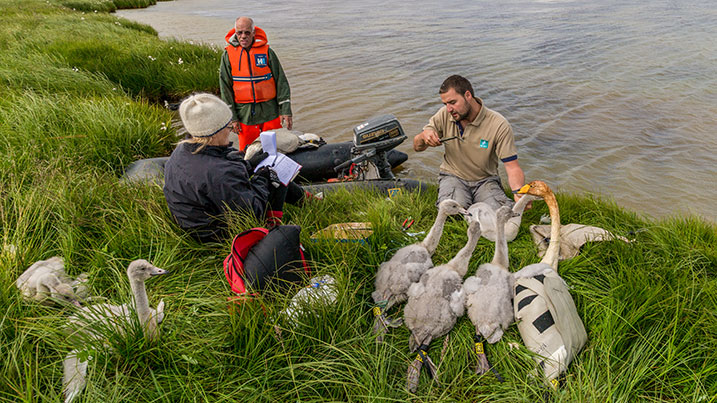If we are to succeed in conserving wetlands, the first step is to have a clear understanding of the state of wetland nature, and the pressures upon it. This allows us to prioritise species, sites and habitats for conservation attention, to identify the threats to them, and to understand how they are responding to conservation action.

WWT was instrumental in establishing repeated, large-scale counts of waterbirds. Waterbirds are relatively easy to see and count, and are good indicators of wetland quality, so such counts have become one of the most powerful tools for long-term monitoring of wetlands. The National Wildfowl Counts were instigated by WWT in 1947, before becoming the Wetland Bird Survey (WeBS), and helping to catalyse the International Waterbird Census (IWC). Currently, WWT organises the UK Goose and Swan Monitoring Programme on behalf of the Joint Nature Conservation Committee and Scottish Natural Heritage. We also aim to support the use of waterbird monitoring into our priority flyways, and currently partner with WWF-China to develop monitoring in the Yangtze valley, one of the most important areas on the East Asian - Australasian Flyways.
These large-scale programmes have been influential in supporting wetland conservation through allowing the identification of priority wetlands under the Ramsar Convention, the EU Birds Directive and national legislation. They allow sites that are under threat to be identified.
In parallel with large-scale bird counts, we run more detailed long-term monitoring of the demographic rates of selected waterbird species, including some of the longest continuous wildlife monitoring programmes on earth. Currently we hold long-term capture-resight data-sets from marked populations of Svalbard barnacle goose, whooper swan and Bewick’s swan, as well as shorter-term data-sets on a number of other species.
We also monitor pressures on wetland nature, to determine how they are changing over time, and whether our conservation work is bearing fruit. For example, we have a long-term programme of x-raying captured swans, to determine whether they have shot embedded in their tissues, which can be used as an index of hunting pressure. Similarly, we run long-term surveillance of the causes of waterbird mortality and the prevalence of wildlife disease.
Projects
- Bewick's swans
- Developing capacity in the East Asian - Australasian flyway
- Goose and Swan Monitoring Programme
- Long-term demographic monitoring of barnacle geese and whooper swans
- Wild bird disease surveillance